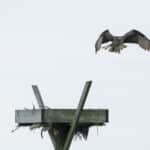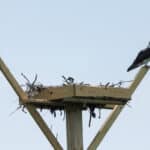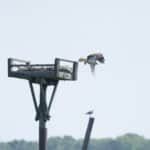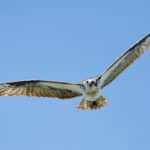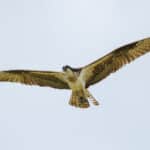Photos From the Field
Summer Re-sightings of Red Banded Ospreys
I never imagined the rewarding experience of observing adult ospreys that I banded as nestlings. Over the past decade, I have banded six hundred and twelve ospreys with field readable red auxiliary bands. These birds originated from nests throughout the Barnegat Bay watershed, from Point Pleasant to Little Egg Harbor. This year, 29 red banded ospreys were re-sighted along the coast of New Jersey.
This project would not have been possible without the support of many people over the years. The project was conceived by my good friend, Jim Verhagen (Northside Jim) in 2013, who created NestStory and recently overhauled Osprey Watch. He saw how NJDEP Fish & Wildlife was banding young peregrine falcons and bald eagles with field readable color bands and wondered why ospreys weren’t included.
Banding migratory birds with field readable color bands allows us to track them – to and from their wintering grounds – and also on their breeding grounds. This is where I encounter these birds. The bands can be read from a distance, where your typical bird bands cannot (they are more centered on being read in hand or after harvest – in the case of game birds). When conducting nesting surveys, I look for birds with bands. Using a telephoto lens and fast action mirrorless camera, I take photos, hoping to nail a photo of their right leg – in focus and not obstructed – all while piloting our boat, directing staff and volunteers, making notes, holding fish, and passing ladders off our boat. It is a challenging task.
As I look back today, I recall memories of banding these birds with other people and other memorable factors, like a stunning sunrise or a sunset. This year, as we mark a decade from beginning this osprey banding and re-sighting project on Barnegat Bay, Project RedBand has allowed us to track individual birds through re-sightings. We’re learning more and more about them, like where they nest, how long the keep their pair bonds, their age, and if they move nests. We also learn more about their migration routes, foraging patterns and more.



One particular osprey that I encountered for the first time this year was 01/C, that was one of the first ospreys that I banded with red bands in 2014 on Long Beach Island with a huge supporter of our osprey conservation initiatives in the LBI Region. I first saw him last year, on a new ground nest at Sedge Island WMA. I got photos of him as he took off from but was unable to read his band. He and his mate had three eggs but they later lost their clutch, as did many other ospreys that year. This year, he settled down on a new nest and I was able to get more photos of him to successfully read his band.

It has really been an amazing year of re-sighting ospreys. Overall, 29 red banded ospreys were re-sighted this year, of 36 total that were re-sighted. In addition, most were re-sighted while alive, which is a stark contrast to most band encounters/re-sightings before banding with auxiliary/field readable bands were deployed. The majority of banded birds were observed on our near nest during nest surveys on Barnegat Bay and a few others were re-sighted in other areas. Full results will be published soon in our 2024 New Jersey Osprey Project Report.
Thank you to everyone who continues to support our fieldwork with ospreys in New Jersey! Whether you contribute monetarily or with your time, it is really greatly appreciated and has helped ensure our management efforts have been a true success.
Discover more from Conserve Wildlife Foundation of NJ
Subscribe to get the latest posts sent to your email.



